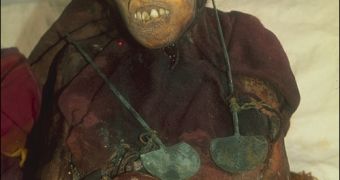The gods asked for their sacrifice in the Andes mountains, and now the Inca children represent one of the best naturally cold preserved mummies. DNA and isotope analyses made by a team led by Andrew Wilson of the University of Bradford in England on the hair samples taken from 4 Inca children mummies and small bags accompanying them revealed that the ancient Inca chose children as young as 6, "fattened them up" for a year and sent them on a sacrifice pilgrimage.
Amongst the sampled mummies were the 15-year old "Llullaillaco Maiden" and the 7-year old "Llullaillaco Boy", discovered in 1999 at a shrine 25 m (83 ft) from the top of Mount Llullaillaco, a 6,739 m (22,470 ft) volcano located between Argentina and Chile.
The children had a hair cut first a year and then six months before their sacrifice. Chemicals from their hair revealed what they ate. The Inca formed the largest empire in the pre-European South America, stretching from Ecuador to Chile (but their power center was in Peru), till they were conquered by Spaniards led by Francisco Pizarro around 1533.
Sons and daughters of local rulers were selected for sacrifice, this way, the Incas spread fear into their governed populations. Some girls, around the age of four, were put under the custody of priestesses; some would later be given as wives to local nobles, others made priestesses and others sacrificed.
The children's early alimentation was initially based on vegetables like the potato, but in the last year of life, they received corn, an elite food for the Inca, and animal protein, perhaps from charki (dried llama meat).
"Given the surprising change in their diets and the symbolic cutting of their hair, it appears that various events were staged in which the status of the children was raised. In effect, their countdown to sacrifice had begun some considerable time prior to death." said Wilson.
The hair samples also indicated that 3 to 4 months before death, the children started their pilgrimage to the heights of the Andes, probably from Cuzco, the imperial capital. It is not known how the children were sacrificed, but it seems that they received maize beer (chicha) and coca leaves in their last moments, possibly to ease the symptoms of altitude sickness and also to inure them to their fate. "It looks to us as though the children were led up to the summit shrine in the culmination of a yearlong rite, drugged and then left to succumb to exposure," said co-author Timothy Taylor, also of the University of Bradford.
"Although some may wish to view these grim deaths within the context of indigenous belief systems, we should not forget that the Inca were imperialists too, and the treatment of such peasant children may have served to instil fear and facilitate social control over remote mountain areas."
A previous research revealed that Llullaillaco Boy had a horrific death, vomit and diarrhea on his clothes pointing to terror. The vomit contained the hallucinogenic drug achiote, also encountered in his stomach and feces. The boy was likely asphyxiated, his body being crushed by his clothes, so strongly that his ribs and pelvis were broken.

 14 DAY TRIAL //
14 DAY TRIAL //